
|
PE(15:0/20:0) |
PE(15:0/20:0) is a lipid of Glycerophospholipids (GP) class. Pe(15:0/20:0) is associated with abnormalities such as Exanthema, Infection, Painful Bladder Syndrome, Obesity and Fatty Liver. The involved functions are known as conjugation, Transcription, Genetic, Sinking, Autophagy and Protein Biosynthesis. Pe(15:0/20:0) often locates in membrane fraction, soluble, Membrane, Body tissue and Tissue membrane. The associated genes with PE(15:0/20:0) are GABARAPL2 gene, ATG10 gene, ATG12 gene, SLC33A1 gene and GABARAP gene. The related lipids are Liposomes, Lipopolysaccharides, Phosphatidylserines, Membrane Lipids and Cardiolipins. The related experimental models are Knock-out and Cancer Model. |
723 |

|
1-Oleoyl Lysophosphatidic Acid |
1-Oleoyl Lysophosphatidic Acid is a lipid of Glycerophospholipids (GP) class. 1-oleoyl lysophosphatidic acid is associated with abnormalities such as Myocardial Infarction, early pregnancy, Scleroderma, Blind Vision and Hyperlipidemia. The involved functions are known as Agent, Blood coagulation, Selection, Genetic, Analyte and Biological Processes. 1-oleoyl lysophosphatidic acid often locates in Tissue specimen, Body tissue, Blood, Membrane and Skin. The associated genes with 1-Oleoyl Lysophosphatidic Acid are Mucin-16, Peptides, SMAD4 gene, RND1 gene and Polypeptides. The related lipids are lysophosphatidic acid, A(2)C, Lysophospholipids, Fatty Acids and sphingosine 1-phosphate. The related experimental models are Mouse Model, Knock-out, Cancer Model, Xenograft Model and Arthritis, Adjuvant-Induced. |
3463 |

|
lysophosphatidic acid |
lysophosphatidic acid is a lipid of Glycerophospholipids (GP) class. Lysophosphatidic acid is associated with abnormalities such as Atherosclerosis, Alzheimer's Disease, Asthma, Diabetes Mellitus, Non-Insulin-Dependent and Septicemia. The involved functions are known as Inflammation, Chemotaxis, Binding (Molecular Function), Polymerization and Inflammatory Response. Lysophosphatidic acid often locates in Cytoskeleton, Microfilaments, actin cytoskeleton, Extracellular and Structure of germinal center of lymph node. The associated genes with lysophosphatidic acid are TNF gene, MAPK3 gene, RHOA gene, CDC42 gene and ADRBK1 gene. The related lipids are lysophosphatidic acid, Lipopolysaccharides, Lysophosphatidylcholines, Lysophospholipids and Phosphatidic Acid. The related experimental models are Knock-out, Transgenic Model, Rodent Model and Disease model. |
820 |

|
trichostatin A |
Trichostatin is a lipid of Polyketides (PK) class. Trichostatin is associated with abnormalities such as Dentatorubral-Pallidoluysian Atrophy, PARAGANGLIOMAS 3, abnormal fragmented structure, Disintegration (morphologic abnormality) and Hyperostosis, Diffuse Idiopathic Skeletal. The involved functions are known as Acetylation, Cell Differentiation process, histone modification, Gene Silencing and Transcriptional Activation. Trichostatin often locates in CD41a, Hematopoietic System, Chromatin Structure, Blood and Endothelium. The associated genes with Trichostatin are SPI1 gene, CELL Gene, Chromatin, CXCR4 gene and DNMT1 gene. The related lipids are Butyrates, Promega, butyrate, Lipopolysaccharides and Steroids. The related experimental models are Knock-out, Mouse Model, Xenograft Model and Cancer Model. |
5401 |
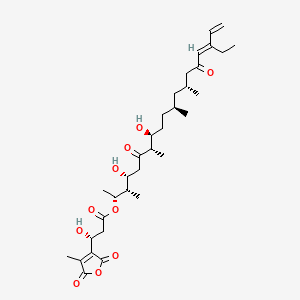
|
Tautomycetin |
Tautomycetin is a lipid of Polyketides (PK) class. Tautomycetin is associated with abnormalities such as Toxic nephropathy and Dehydration. The involved functions are known as Signal, Regulation, Increased Sensitivy, Increased Device Sensitivity and phosphoric monoester hydrolase activity. Tautomycetin often locates in Neurosecretory Systems, Protoplasm, Mitochondria, Transplanted tissue and Blood. The associated genes with Tautomycetin are RAF1 gene, IL2 gene, IL2RA gene, BCL2 gene and cytochrome c''. The related lipids are branched chain fatty acid and Propionate. |
102 |
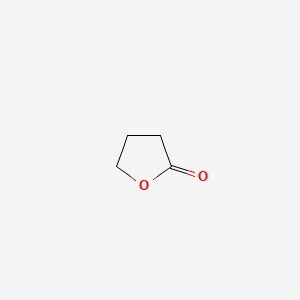
|
Gamma-butyrolactone |
Gamma-butyrolactone is a lipid of Fatty Acyls (FA) class. |
4604 |
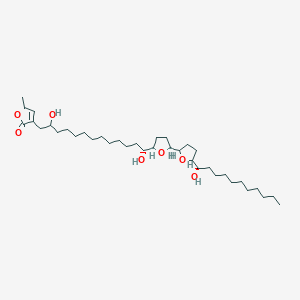
|
Rolliniastatin-1 |
Rolliniastatin-1 is a lipid of Polyketides (PK) class. |
55 |
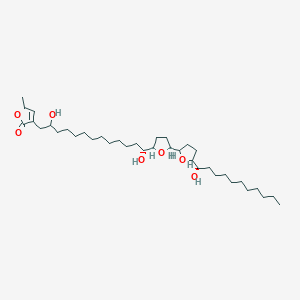
|
Bullatacin |
Bullatacin is a lipid of Polyketides (PK) class. The involved functions are known as inhibitors, Electron Transport, NADH-ubiquinone oxidoreductase activity, NADH oxidation and Point Mutation. Bullatacin often locates in NADH dehydrogenase complex and Submitochondrial Particles. The associated genes with Bullatacin are NDUFS7 gene, CCL14 wt Allele and TERT gene. The related lipids are Annonaceous Acetogenins. |
124 |
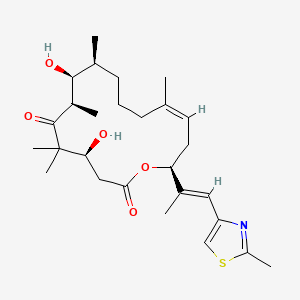
|
Epothilone D |
Epothilone d is a lipid of Polyketides (PK) class. Epothilone d is associated with abnormalities such as Tauopathies, Neutropenia, Neuropathy and Hematological Disease. The involved functions are known as Mutation, Apoptosis, Mitotic arrest, Cell Growth and Anabolism. Epothilone d often locates in Cytoskeleton, Axon, Cell Wall, Chromosomes and Spindle. The associated genes with epothilone D are SLC33A1 gene, Chromatin, GTF2I gene and HEXA gene. |
174 |

|
tacrolimus |
Tacrolimus is a lipid of Polyketides (PK) class. Tacrolimus is associated with abnormalities such as Renal glomerular disease. The involved functions are known as inhibitors, Fungicidal activity, Metabolic Inhibition, Excretory function and Dephosphorylation. Tacrolimus often locates in Hepatic, Mitochondrial matrix and Inner mitochondrial membrane. The associated genes with Tacrolimus are RHOA gene and BGN gene. |
12730 |

|
erythromycin |
erythromycin is a lipid of Polyketides (PK) class. Erythromycin is associated with abnormalities such as Systemic Inflammatory Response Syndrome, Pneumonia, Infection, Pneumococcal Infections and Exanthema. The involved functions are known as Pharmacodynamics, Sterility, Agent, Drug Kinetics and Adjudication. Erythromycin often locates in Blood, peritoneal, Extracellular, Ribosomes and apicoplast. The associated genes with erythromycin are P4HTM gene, SLC33A1 gene, FAM3B gene, Operon and Homologous Gene. The related lipids are Hydroxytestosterones, Steroids, Propionate, Mycolic Acids and campesterol. The related experimental models are Mouse Model and Knock-out. |
19871 |

|
clarithromycin |
clarithromycin is a lipid of Polyketides (PK) class. Clarithromycin is associated with abnormalities such as Helicobacter Pylori Infection, Infection, Coinfection, Gastritis and Peptic Ulcer. The involved functions are known as Point Mutation, Increased Sensitivy, Bacterial resistance, urease activity and Mutation. Clarithromycin often locates in Blood, Gastric mucosa, Biopsy sample, Respiratory System and Entire gastrointestinal tract. The associated genes with clarithromycin are Genes, rRNA, rRNA Operon, Genome, HM13 gene and GDF15 gene. The related lipids are 9,11-linoleic acid, Steroids, Lysophosphatidylcholines, Lipopolysaccharides and 4-hydroxycholesterol. The related experimental models are Mouse Model, Knock-out and Experimental Pneumococcal Meningitis. |
10449 |

|
ZEARALENONE |
ZEARALENONE is a lipid of Polyketides (PK) class. Zearalenone is associated with abnormalities such as HYPOTRICHOSIS, LOCALIZED, AUTOSOMAL RECESSIVE, 2, Estrogen excess, Food-Drug Interactions, Osteomalacia and Osteoporosis. The involved functions are known as mRNA Expression, Metabolic Inhibition, Phosphorylation, Agent and Transcriptional Activation. Zearalenone often locates in Gastrointestinal tract structure, soluble, viral nucleocapsid location, Spindle and Hepatic. The associated genes with ZEARALENONE are Candidate Disease Gene, Genome, Genes, Reporter, P4HTM gene and Open Reading Frames. The related lipids are Lipopolysaccharides, Steroids, Fatty Acids and Promega. The related experimental models are Transgenic Model. |
2573 |

|
Epothilone A |
Epothilone a is a lipid of Polyketides (PK) class. Epothilone a is associated with abnormalities such as abnormal fragmented structure and Hyperostosis, Diffuse Idiopathic Skeletal. The involved functions are known as Polymerization, Mutation, Depolymerization, Musculoskeletal torsion, function and Negative Regulation of Microtubule Depolymerization. Epothilone a often locates in Microtubules, soluble, Nuclear Structure and Microtubule cytoskeleton. The associated genes with Epothilone A are C9 gene, SLC33A1 gene, KIF2C gene and HMHA1 gene. |
160 |
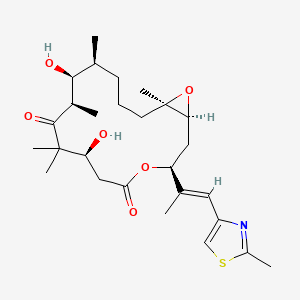
|
Epothilone B |
Epothilone B is a lipid of Polyketides (PK) class. Epothilone b is associated with abnormalities such as Myelosuppression, Measurable Disease, Neuropathy, Neutropenia and Thrombocytopenia. The involved functions are known as Cell Cycle Arrest, Apoptosis, Signal Transduction, Cytokinesis and Caspase Activation. Epothilone b often locates in Mitochondria, Cytoplasmic matrix, Microtubules, Spindle and Protoplasm. The associated genes with Epothilone B are TNFSF10 gene, DIABLO gene, FADD gene, BCL2 gene and BCL2L1 gene. The related lipids are Promega and Phosphatidylserines. The related experimental models are Xenograft Model and Mouse Model. |
492 |

|
nystatin |
nystatin is a lipid of Polyketides (PK) class. Nystatin is associated with abnormalities such as Virus Diseases, Infection, Candidiasis, Leukopenia and Mycoses. The involved functions are known as Membrane Potentials, Uptake, Flow or discharge, Cell membrane potential and adenine transport. Nystatin often locates in Cell Wall, Plasma membrane, Extracellular, Membrane and Virion. The associated genes with nystatin are Genome, Integral Membrane Proteins, Amino Acids, Basic, P4HTM gene and Homologous Gene. The related lipids are Sterols, Liposomes, Membrane Lipids, Sphingolipids and 1,2-oleoylphosphatidylcholine. The related experimental models are Knock-out and Xenograft Model. |
4890 |
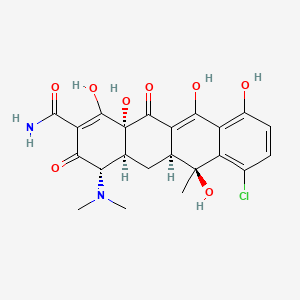
|
chlortetracycline |
chlortetracycline is a lipid of Polyketides (PK) class. Chlortetracycline is associated with abnormalities such as Granulomatous Disease, Chronic, Infection, Ischemia, Cerebral Ischemia and Cerebral Infarction. The involved functions are known as Regulation, Binding (Molecular Function), Agent, Stimulus and Process. Chlortetracycline often locates in Protoplasm, Plasma membrane, Membrane, Cytoplasm and specific granule. The associated genes with chlortetracycline are FPR1 gene, P4HTM gene, Homologous Gene, HIST1H1C gene and Microbiome. The related lipids are Lysophosphatidylcholines, Sterols, dilauroyl lecithin, seminolipid and Total cholesterol. The related experimental models are Mouse Model. |
6144 |

|
oxytetracycline |
oxytetracycline is a lipid of Polyketides (PK) class. Oxytetracycline is associated with abnormalities such as Infection, X-linked centronuclear myopathy, Bacterial Infections, Heart failure and Onchocerciasis. The involved functions are known as Anabolism, physiological aspects, Transcription, Genetic, Fermentation and Transcriptional Activation. Oxytetracycline often locates in Chromosomes, Flank (surface region), Entire bony skeleton, Bone Marrow and Body tissue. The associated genes with oxytetracycline are Polypeptides, Homologous Gene, Gene Clusters, Locus and CYCS gene. The related lipids are LH 1 and Lipid Peroxides. The related experimental models are Disease model. |
6787 |
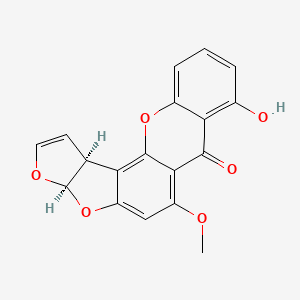
|
STERIGMATOCYSTIN |
STERIGMATOCYSTIN is a lipid of Polyketides (PK) class. Sterigmatocystin is associated with abnormalities such as CLEFT LIP, CONGENITAL HEALED, Exanthema and Lung diseases. The involved functions are known as sterigmatocystin biosynthetic process, Signal, secondary metabolic process, Biosynthetic Pathways and Anabolism. Sterigmatocystin often locates in Genital system, SAGA complex, Chromosomes, germ tube and Extracellular. The associated genes with STERIGMATOCYSTIN are Genome, Genes, vif, Homologous Gene, Genes, Regulator and Gene Clusters. The related lipids are hexanoic acid, Fatty Acids and Fatty Acids, Unsaturated. |
891 |
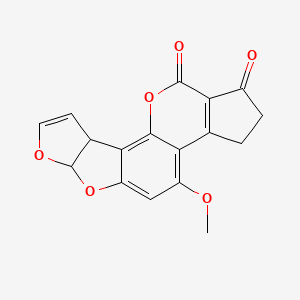
|
AFBI |
AFBI is a lipid of Polyketides (PK) class. Afbi is associated with abnormalities such as Pyotraumatic dermatitis, Infection, Hepatitis, Liver diseases and Hepatitis B. The involved functions are known as Immune response, Mutation, Anabolism, Metabolic Inhibition and Increased Sensitivy. Afbi often locates in Body tissue, Hepatic, Cytoplasm, Blood and Micronucleus. The associated genes with AFBI are TP53 gene, Genome, Transgenes, FATE1 gene and MANEA gene. The related lipids are Lipopolysaccharides, Lipid Peroxides, 1-(2-cyano-3,12-dioxooleana-1,9-dien-28-oyl) imidazole and Liposomes. |
5774 |



















